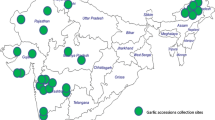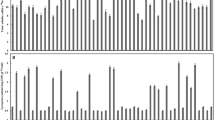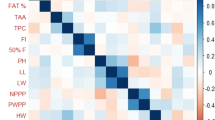Abstract
Indian pennywort (Centella asiatica L.) is an emerging medicinal cum nutraceutical herb known for its neuroprotective properties. The antioxidant activity is an important parameter for its supposed benefits. Currently the genetic diversity of the crop remains underexploited and research related to genetic variability of antioxidant activity and its component traits is limited. This experiment was carried out to know the genetic variability in the nutraceutical compositions in 20 accessions collected from hill zone of Karnataka, India (with three checks viz., Arka Prabhavi, Arka Divya and Vallabh Medha). The results showed a wide variation among the accessions for mineral composition viz., phosphorus, potassium, calcium, iron and zinc; phytochemical constituents viz., total carotenoids, anthocyanin, total phenols, total flavonoids, tannins, oxalates, ascorbic acid and antioxidant activity. Most of the parameters such as iron, zinc, total carotenoids, anthocyanin, total phenols, oxalates and antioxidant activity showed higher genotypic and phenotypic coefficient of variability (GCV and PCV, respectively). All the parameters showed higher heritability and genetic advance. Total flavonoids, zinc and total phenols were ascertained to be the major contributors of antioxidant activity according to correlation and path analysis research. The grouping of the accessions based on Mahalanobis D2 analysis resulted in five clusters. These suggests the wider genetic diversity among the accessions. Further, the traits are governed by additive gene action indicating that these characters could be considered for selection for further crop improvement for antioxidant activity.

Similar content being viewed by others
Data availability
No datasets were generated or analysed during the current study.
References
Alba TM, Tessaro E, Sobottka A (2022) Seasonal effect on phenolic content and antioxidant activity of young, mature and senescent leaves from Anredera cordifolia (Ten.) Steenis (Basellaceae). Braz J Biol 84:254–269
AOAC (1980) Official Methods of Analysis, 13th edition. Association of Official Agricultural Chemists, Washington, D. C
Azmin SNHM, Nor MSM (2020) Chemical fingerprint of Centella asiatica’s bioactive compounds in the ethanolic and aqueous extracts. Adv Biomark Sci Technol 2:35–44
Belwal T, Andola HC, Atanassova MS, Joshi B, Suyal R, Thakur S, Bisht A, Jantwal A, Bhatt ID, Rawal RS (2019) Gotu kola (Centella asiatica). In: Nabavi SM, Silva AS (eds) Nonvitamin and nonmineral nutritional supplements. Academic Press, pp 265–275
Blois MS (1958) Antioxidant determinations by the use of a stable free radical. Nature 181(4617):1199–1200
Chandrasekara CHWMRB, Sumanarathne RAPI, Bandaranayake PCG (2020) Centella asiatica morphotypes differ genetically as well as macronutrients content, total phenolic content and chemical fingerprints of leaves. J Agric Sci Sri Lanka 15(1):75–87
Dang BTT, Ngo DN, Vu NB, Dang TTT, Dang XC, Pham TT (2021) The content of polyphenol and chlorophyll, and antioxidant activity of Centella asiatica: accumulation according to the growth times and their correlation. Sapporo Med J 55(6):1–8
Dewey DR, Lu K (1959) A correlation and path-coefficient analysis of components of crested wheatgrass seed production1. Agron J 51(9):515–518
Duara P, Kalita J (2013) An investigation on the pollinating insects of medicinally important plants. Int J Life Sci Biotechnol Pharm Res 2(1):318–324
Falconer DS (1989) Introduction to quantitative genetics, 3rd edn. Longman, New York
Fuleki T, Francis FJ (1968) Quantitative methods for anthocyanins 1 extraction and determination of total anthocyanin in cranberries. J Food Sci 33:72–77
Harland SC (1939) The genetics of cotton. Jornathan cape, London
Hassanpour H, Yousef H, Jafar H, Mohammad A (2011) Antioxidant capacity and phytochemical properties of cornelian cherry (Cornus mas L.) genotypes in Iran. Sci Hortic 129:459–463
Hatami M, Karimi M, Aghaee A, Bovand F, Ghorbanpour M (2022) Morphological diversity, phenolic acids, and antioxidant properties in eryngo (Eryngium Caucasicum Trautv): selection of superior populations for agri-food industry. Food Sci Nutr 10:3905–3919
Jackson ML (1973) Soil Chemical Analysis. Prentice Hall of India Private Limited, New Delhi
James JT, Dubery IA (2009) Pentacyclic triterpenoids from the medicinal herb, Centella asiatica (L.) Urban. Molecules 14:3922–3941
Johnson HW, Robinson HF, Comstock RE (1955) Estimates of genetic and environmental variability in soybeans1. Agron J 47:314–318
Kherwar D, Usha K (2016) Genetic variations, character association and path analysis studies in guava (Psidium guajava L.) for bioactive and antioxidant attributes. Indian J Plant Physiol 21:355–361
Koenig R, Johnson C (1942) Colorimetric determination of phosphorus in biological materials. Ind Eng Chem Anal Ed 14(2):155–156
Lal RK, Gupta P, Dubey BK (2017) Genetic variability and associations in the accessions of Manduk Parni {Centella asiatica (L)}. Ind Crops Prod 96:173–177
Mahalanobis PC (1936) On the generalized distance in statistics. Proc Natl Inst Sci India 132:49–50
Mutha RE, Tatiya AU, Surana SJ (2021) Flavonoids as natural phenolic compounds and their role in therapeutics: an overview. Future J Pharm Sci 7:1–13
Naik VV, Mahavidyalaya SPK, Sindhudurg D (2014) Methodology in determination of oxalic acid in plant tissue: a comparative approach. J Glob Trends Pharm Sci 5:1662–1672
Nanditha RJ, Ravi CS, Rohini MR, Girish R, Bhoomika HR (2022) Germplasm collection and characterization of Mandukaparni (Centella asiatica L.) accessions of coastal zone of Karnataka. Pharm Innov J 11(11):893–900
Nwangburuka CC, Denton OA (2012) Heritability, character association and genetic advance in six agronomic and yield related characters in leaf Corchorus olitorius. Int J Agric Res 7:367–375
Nyadanu D, Lowor ST, Akpertey A, Tchokponhoue DA, Pobee P, Dogbatse JA, Okyere D, Amon-Armah F, Brako-Marfo M (2020) Genetic variability of bioactive compounds and selection for nutraceutical quality in kola [Cola nitida (Vent) Schott. And Endl.]. PLoS ONE 15:242–252
Ogunka-Nnoka CU, Igwe FU, Agwu J, Peter OJ, Wolugbom PH (2020) Nutrient and phytochemical composition of Centella asiatica leaves. Med Aromat Plants 9(346):2167–2174
Panse NG, Sukhatme PV (1985) Statistical methods for agricultural workers. ICAR, New Delhi
Popat R, Patel R, Parmar D (2020) Variability: genetic variability analysis for plant breeding research. R package version 0.1.0
Prasad A, Mathur AK, Mathur A (2019) Advances and emerging research trends for modulation of centelloside biosynthesis in Centella asiatica (L.) urban-a review. Ind Crops Prod 141:111–128
Ranganna S (1986) Handbook of analysis and quality control for fruits and vegetable products. Tata Mc Graw Hill, New Delhi
Rao CR (1952) Advanced statistical methods in biometrical research. Wiley, New York
Ravi CS, Umesha K, Himabindu K, Shetty GR, Kumar GA (2019) Collection and morphological variability in ecotypes of indian pennywort (Centella asiatica L.) of hill zone of Karnataka India. Int J Curr Microbiol Appl Sci 8:994–1008
Rohini MR, Smitha GR (2021) Studying the effect of morphotype and harvest season on yield and quality of Indian genotypes of Centella asiatica: a potential medicinal herb cum underutilized green leafy vegetable. South Afr J Bot 145:275–283
Sadasivam S, Manickam A (1991) Biochemical methods. New Age International Pvt Ltd, TNAU, Coimbatore
Sarker U, Oba S (2020) Nutraceuticals, phytochemicals, and radical quenching ability of selected drought-tolerant advance lines of vegetable amaranth. BMC Plant Biol 20:1–16
Sarker U, Islam MT, Rabbani MG, Oba S (2016) Genetic variation and interrelationships among antioxidant, quality, and agronomic traits in vegetable Amaranth. Turk J Agric For 40:526–535
Sarker U, Islam MT, Rabbani MG, Oba S (2017) Genotypic diversity in vegetable amaranth for antioxidant, nutrient and agronomic traits. Indian J Genet Plant Breed 77:173–176
Sarker U, Islam MT, Rabbani MG, Oba S (2018) Variability in total antioxidant capacity, antioxidant leaf pigments and foliage yield of vegetable amaranth. J Integr Agric 17:1145–1153
Seevaratnam V, Banumathi P, Premalatha MR, Sundaram SP, Arumugam T (2012) Functional properties of Centella asiatica (L.): a review. Int J Pharm Pharm Sci 4(5):8–14
Shin HY, Kim H, Jung S, Jeong EJ, Lee KH, Bae YJ, Suh HJ, Jang KI, Yu KW (2021) Interrelationship between secondary metabolites and antioxidant capacities of Centella asiatica using bivariate and multivariate correlation analyses. Appl Biol Chem 64(1):1–10
Singh S, Gautam A, Sharma A, Batra A (2010) Centella asiatica (L): a plant with immense medicinal potential but threatened. Int J Pharm Sci Rev Res 4(2):9–17
Singh S, Singh DR, Banu VS, Avinash N (2014) Functional constituents (micronutrients and phytochemicals) and antioxidant activity of Centella asiatica (L.) Urban leaves. Ind Crops Prod 61:115–119
Singleton VL, Orthofer R, Lamuela-Raventós RM (1999) Analysis of total phenols and other oxidation substrates and antioxidants by means of folin-ciocalteu reagent. Methods Enzymol 299:152–178
Upadhyay S, Mehta N, Tiwari AK (2019) Assessment of variability among flax type linseed genotypes (Linum usitatissimum L.) of Chhattisgarh plains. Int J Curr Microbiol Appl Sci 8(06):2633–2637
Whittaker A, Vazzana C, Vecchio V, Benedettelli S (2009) Evaluation of direct and indirect effects of flavonoids, mineral elements and dry weight on antiradical scavenging activity in leaf material of field-grown Trifolium pratense cultivars using path analysis. Field Crops Res 113:1–11
Wright S (1921) Correlation and causation. J Agric Res 20:557–585
Wulandari P, Daryono BS, Supriyadi (2017) The effect of ripening stages on the antioxidant potential of melon (Cucumis melo L) cultivar Hikapel. AIP Conference Proceedings , American Institute of Physics Inc 1854(1):34–47
Zhishen J, Mengcheng T, Jianming W (1999) The determination of flavonoid contents in mulberry and their scavenging effects on superoxide radicals. Food Chem 64:555–559
Acknowledgements
We are thankful for the Dean and Head of the Department (PSMAC), College of Horticulture, Mudigere, Keladi Shivappa Nayaka University of Agricultural and Horticultural Sciences, Shivamogga, Karnataka, India for extending the facilities to conduct the research.
Funding
No external funds were received for conducting the research.
Author information
Authors and Affiliations
Contributions
All the authors have contributed for conducting the research, analytical parts, calculations and statistical analyses.
Corresponding author
Ethics declarations
The authors declare they have no conflict of interest.
Conflict of interest
The authors declare no competing interests.
Additional information
Publisher’s Note
Springer Nature remains neutral with regard to jurisdictional claims in published maps and institutional affiliations.
Rights and permissions
Springer Nature or its licensor (e.g. a society or other partner) holds exclusive rights to this article under a publishing agreement with the author(s) or other rightsholder(s); author self-archiving of the accepted manuscript version of this article is solely governed by the terms of such publishing agreement and applicable law.
About this article
Cite this article
Abhishek, J.K., Ravi, C.S., Sudharani, N. et al. Genetic diversity analysis for nutraceuticals and antioxidant activity in selected Indian pennywort (Centella asiatica L.) accessions of hill zone of Karnataka. Genet Resour Crop Evol (2024). https://doi.org/10.1007/s10722-024-01871-1
Received:
Accepted:
Published:
DOI: https://doi.org/10.1007/s10722-024-01871-1




